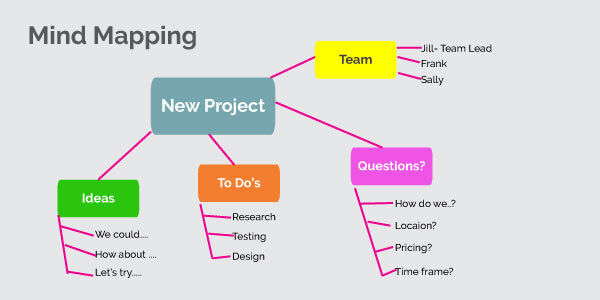We’re going to cover the different modes of thinking. So, from logic to create and how you can use them together to generate better ideas and solutions. We look at creative problem-solving.
So that we can help solve problems in our businesses and our personal lives a little better. We also look at how to implement creative thinking more in the workplace. So that we’re not stuck doing the same processes and getting the same results. So we can implement more change.
And lastly, we’re going to look at how to generate more creative thinking in our lives. One way we’re going to look at is meditation, by clearing our minds. We’re able to think a little bit more creatively. We attached a series of exercises that you can do to help generate more creativity in your life or distribute to your teams in the workplace.
Download the resource file from here:
Three Modes of Thinking:
We’re going to go over the modes of thinking more creatively. We’re also going to go over how to start implementing creative thinking in our lives. Some exercises we can do to help promote creative thinking.
And we especially can take a look at how we can utilize creative thinking in our businesses and implement creative thinking programs in our business to help generate more thoughts. There are three modes of thinking. Divergent, conversion, in a lateral.

Divergent:
In divergent thinking, we’re going to be using our imagination. This is going to be the side that we’re pulling from if we’re doing art or anything abstract. So if you think Picasso or if you think of that old painting with the melting clocks. Right? Surrealism that’s a lot of creative thinking there’s not a lot of logic to that. Clocks don’t melt like that. It’s not going to work. It’s not real. It’s just creative thought.
Convergent:
Convergent thinking which is using logic. So if we think of math. Here in math class what is math. Teach you? Math teaches you logically and problem-solving specifically it teaches you problem-solving logically. So we’re all taught that in school is the most common way that we’re all taught to solve problems.
Lateral thinking:
Lateral thinking which is utilizing both. So we’re going to take elements of logical thought or take elements of creative thinking using our imagination or push those together to find conclusions. That’s a really good creative solution because not only have we found something new and created something we’ve also used our logic to justify it.
Convergent – Using Logic:
Conversion thought using logic generally trying to find a solution to a problem is the best solution. With this many solutions are going to be evaluated. Generally means the ability to give a correct answer to standard questions that don’t require significant creativity.
The best example of this is when you’re going to school and they give you multiple-choice answers. We all did this where I went to school where they gave us a standardized test every year to test where we were at versus what the state thought we should be.
The term funding for our schools. So, we all had to fill in a little bubbles color dancers any colors a and all that and you go through and everyone’s supposed to get the same answer. There’s no divergent thought there. Religion should be the same.
Conversion thinking is often used in conjunction with divergent thinking to justify the divergence. So come up with a creative idea. You’re going to use logic to back that up and make sure it’s a good idea. Validation conversion of thought process is going to be something used more in statistical analysis. So we can take a group of values for how the company has been doing in sales right.
So we’re going to predict what our next year should be based on our growth and only based on our growth over the last few years. But based on what we typically do each month. So most businesses have busy times and slow times of the year depending on seasonality.
So if we know in June we’re going to have our slowest month or in December we’re going to have our slowest month. We probably shouldn’t be expecting the trend line of our revenue to continue in that timeframe. Logically we’d want to look at it and say, January December or January,
February March, April, we’re going to increase in value every month. We’re going to grow in the amount we’re selling. Then April is going to slow down a little bit. May it’s going to slow down all the more. In June we’re going to have our slowest month of the year.
But knowing that, we can do things to counteract you know June’s our slowest month. June is the time to make changes. June is the time to make adjustments a test new things because it’s already slow.
We know we’re not going to bring as much revenue. But we already have all the staff needed for our having revenue season. So let’s make use of that. So we can draw logical conclusions using this version of thinking.
With convergent thinking, we also want to make sure that you’re driving the best solution and typically one solution. So with this is the one answer. You want to be able to tell someone apart from others who are using mostly logical thinking versus creative thinking.
What you’re going to want to look for is a type-A person who finds one solution and that is the solution. For the rest of their lives, That’s the solution to that problem.
Why do they do it once it worked once why solve it in another way. And it makes sense if you think about it. That stream of thought does make sense and it does work a lot in businesses.
But a lot of companies end up not growing simply because they don’t take the time to take a step back re-evaluate how they’re doing things and add a creative spin and say we’ve done it this way for 10 years but if we change this process a little bit. We can cut production time down by 10 percent. Meaning we can produce 10 percent more games. Many businesses get caught in this cycle of doing the same thing forever.
Logic Example:
Discuss previously logic is a great thought process for statistical analysis using statistics to drive sales. In this example, we want to look at placing products together may be from an online store. So you may notice that customers visiting your store or buying two items to either say it’s a scarf or hat. 20 percent of the time one of these is bought. They’re being bought together. That would mean the usual.
The consensus is these products look at together based on your customer base. You can then use analysis on your website you can use marketing and you can say Great. Let’s put these two together and add them on Facebook.
Because based on our sales the scarf is selling more when we advertise it on Facebook. So these go together let’s put the two together are Facebook ads. And see if sales increase. So we’re making logical assumptions, applying it to something we’re already doing, and then we’re testing to see if it works.
Another great example is email marketing. We’re doing split testing and e-mail marketing. Typically to see which customer bases are going to open which e-mails. So you have your subject line create three subject lines take 20 percent of your cool e-mails and you break the three parts and then you send a different headline for the email is. Each of those headlines you break those sections.
If you have a big enough list into three more sections where underneath it, they have a different body of the email. So in the body of the emails, you’re trying to see which version of the body the email that you put together will get the most clicks on your link.
That’s your Web site to drive sales. And then from that, you can also look at which was visited the most and which got the most actual conversions on sales. So, we can say we have lived or we have e-mail headline ABC. B gets the most opens. ANC does OK. So, the primary one we’re going to send to the rest of our 80 percent of our list is B.
We’ll look at the inside of the email. We know one of them got a lot of clicks but no conversions, and we know one of them got slightly fewer clicks but they got a lot more conversions on sales. So, we may take the e-mail from the headline that got the most clicks open.
We’ll take the email the body that got the most clicks and then we’ll take the page that we were sending people to it got the most. That way we’re taking the bulk of our marketing and we’re applying it to our solution Logically, statistically has driven the best results.
Divergent- Using Imagination:
Divergent thought is that using imagination. So, it’s more spontaneous. It’s when you’re just creating things that maybe don’t make sense sometimes. For instance, a picture of a panda with boxing gloves on a pandas outbox. It’s just silly. Divergent thinking is a thought process or method used to generate creative ideas by exploring many possible solutions. We want a variety of ideas.
We want a lot of value. I want a lot to discuss. Divergent ideas typically drive a lot of discussions and create more ideas from them. And that’s the idea. So, you want to start with the base idea and it kind of turns into a landslide of ideas coming down the mountain. It’s getting more and more powerful as it builds up. And gains of more variety of ideas to pull from.
Divergent Example:
For example, this is brainstorming or free writing mind mapping you take an idea you put it in the center Ward. Bring your team into a group. You say hey look at this, this is our problem. We’re going to map out some solutions. What are different ways we can approach this work? What are the consequences of those ways?
What are the benefits of those ways? And you can map out which ideas lead you to which ideas and see if any come together, and if they do come the other then you can look at doing them kind of as a joint idea and find their differences, and maybe two solutions put together to complement each other enough to apply some logic on the back end and see if it’ll work.
Here’s also another good time to talk about problem-solving inside an organization. A good way to use divergent thought is to sometimes ask another department what they would do. So, if your team is programming for a module of your software.
Say you’re building out an order entry portal. You’re having a problem with code you can’t quite figure out what or process you want things to go through with the sales flow. So, you might bring in another team to say hey this is what we’re trying to do.
These are our ideas are how would you do this. For your team and maybe the other team primarily deals with an inventory management module. Or they deal with a data capture module for your product. But they’re building things and programming still may have an idea of how things work in your product. And they can bring a different kind of perspective.
So, bringing in just a third-party perspective can help to drive more creative solutions from people who might not be invested in the solution.
Lateral Thinking:
Lateral thinking is thinking of using creative and logical thought. So, by pushing together the conversion and logical thought process, we’re able to help create a wholly new solution. And has justification behind it. We want to do this with statistical analysis, we’re looking at past trends. We’re justifying our creative idea.
By doing this pushing these together we have more they are made a higher success. Chance by doing this may be a higher success chance with our solution. Because we come up with a wholly new solution, but we’ve justified without lateral thought.
Lateral Thinking Example:
Great examples of lateral thought are Uber. It’d be great to just be able to take a call to Brian. No one wants to use cabs anymore because Uber cars are expensive. It did be great to be able to just go work when you don’t have cash. I’ve got a car, I can go in it, I can sign up for Uber within a few days, I’m driving uber.
Make an extra mile sod, everyone these days has smartphones, everyone can use the app. When it was first developed though, they don’t take all these ideas and say Wouldn’t it be great to do all of them let’s just spread it everywhere immediately.
When it came out Uber had to test it. They had to come up with how we’re going to grow this company, how are we to implement all these things. How are we going to pay drivers? How are we going to get more people to drive for us, and how we’re going to deal with competitors. So they roll now into a series of cities starting in larger cities.
So, they had a larger populace to start with rolling out in smaller cities. In doing so as they learned what was happening, they could use creative thoughts to approach the new markets in different ways and backed that up with their logical thought process based on the previous history. Thus, giving them more creative solutions to grow more quickly as they progressed.

Knowing which method of thinking to apply is critical for our success. Some situations only need logical thought. Some financial decisions are best made simply based on pure logic and financial analysis. And that’s great. But knowing when to put creative logic together, is something that takes time, and it’s something that we kind of do passively inside our minds. Take skill to practice pushing these to others especially if you’re a logical person or an extremely creative person.
So, if you’re more logical it’ll be harder for you to look at this idea that’s so far away from what you’re used to doing that it seems like it might not make any sense. Until you’ve justified it. But you have to be open to the idea of justifying. On the other end, If, you’re a creative person, you might not even be used to the idea of justifying your solutions.
You might be used to more of the idea. I have this great idea. We’re just going to go do it and see what happens. I want to test it that way, and that can work in some situations just like having a logical process can work in some situations. But you’ll have a higher success rate putting them together, utilizing lateral thinking, justifying your creative ideas.
Creative Thinking in the Workplace:
Creative thinking is great to implement in the workplace. It helps to drive a company to be better in general as a company grows. Creative thought can help with scaling. It also helps to drive rationality which can draw more customers and you seem more unique.
Helping to find new solutions, Also is going to increase the wealth of options you have when problems come up. And you get these innovations by having employees feel free to come forward with new ideas, and creative ideas without the feeling that they’re going to be told no that’s wrong or no less stupid or anything. You have to have a culture of creativity in the workplace. Someone has to be comfortable to be creative.

For example, companies that aren’t creative are companies that have been around for a while and they been doing the same process for the last 30 years. For the last 30 years, they’ve had a production line. It’s made the same kinds of parts, with the same kinds of machines, with the same number of people.
But the owners have wanted to want to look at different ways of doing it. Maybe 5 10 years ago there was a new machine that came out a curve replaced one worker for twenty thousand years instead of the forty thousand they make.
That worker could have been used to help with inventory to help with processing to help with shipping. To help fill in areas the business maybe there are other problems or that money could have been pushed back into marketing to help grow the business more.
But because the solutions were not being brought up anyone thought to stop them. Look at what they were doing and create a new creative solution to their problem. Or find a problem with creative thinking.
There are businesses out there that aren’t doing that. Some businesses are just doing the same thing forever because that’s how it’s done. And that’s harmful to your company. The worst thing a company can do is just continue to do something because that’s what they’ve always done.
Implementation:
Implementing a creative program at your company can be difficult. Everyone has to get on board and that’s from top-down. So, from the CEO on down, or are you just in your department from the head of your department down. You have to be open to the idea of creating new ideas of embracing new ideas and not judging people for ideas that might not be good.
The beautiful thing about the creative process is that you get so many good ideas and so many bad ideas altogether and you don’t know which is which until they’re evaluated. And sometimes the worst ideas can lead to the best ideas just from a simple discussion about why something would or wouldn’t work.
It can be difficult for an employee especially one as logical in a practical industry to be and think creatively. Sometimes you have to explain to your staff that you need them to be creative. Brainstorming in meetings is a great way to help promote that especially at the beginning of implementing a creative culture in your company.
By bringing people together in, asking them to get creative in groups, you can promote that while they’re not in a group. So we’re gathering ideas together. Want to hear everyone’s ideas judgment-free zone. Right. Bring that together that way.
They have an idea when they’re home with their kids on Saturday. They see something on TV or something clicks and they’re like I have a solution, come to work Monday with that solution. Willing to bring it up because you have that culture built for it.
One big thing that I’ve always liked is that new experiences generate brain activity with the process of things that way. So, we take a look at that and you think about work we’re doing a standard job going to work. Typically, you’re doing about the same thing every day. But if you change things up or if you move people from different seats, you kind of just reorganize where people are restructuring departments just from where people are sitting.
You can start to create kind of more new ideas just based on that. Because they’re being forced to have a new experience instead of everything being the same every day they move. It creates a different experience when you walk through a doorway and you forget what you want into a room floor. That’s because when you pass through a doorway.
Your mind is pausing for a second and evaluating your new surroundings. By forcing yourself to have those kinds of experiences or new experiences. You’re forcing your mind to evaluate new surroundings or to look at a solution differently.
You could take a team out to do team building activities where they do trust falls or where they do climbing with the support ropes, or someone helps them to go off the wall. I’ve seen that done. There’s a lot of team-building activities you can do that are things that maybe everyone hasn’t done before. That will help them to be in a different experience so they have a larger variety of experiences to from.
So the reason why diversity is so pushed in businesses nowadays it’s because with a diverse background you get more solutions. And you can help with the diversity of your employees by helping the locals to have a diverse amount of experience.
You can bring in speakers that from your community who are good at say marketing. And they can come in and talk to your marketing team about marketing trends that are going out and that might spark new ideas. Because maybe your team didn’t know.
Or maybe your team members just needed to hear it from an outside source. Creating creativity in a company comes down to culture. Everybody’s got to be on board for implementing Moorhead and willing to try the willing to be out you can’t approach it negatively.
Meditation for Creative Thinking:
Here we discuss meditation for creative thinking and meditations. Something you can do pretty much anytime anywhere. You can do it on your lunch break and do it before or after work. It’s something to help just clear your mind calm you down and kind of open up your thought ways for bringing in more creative thought.
So how to meditate simply. It’s kind of like taking a nap or going to sleep except you don’t fall asleep, so you going to find a quiet place to get comfortable. Clear your mind and relax. Very simply that’s at a base what you’re doing here.
Going a little more in-depth What’s helpful is once you find this comfortable place to clear your mind or to stop thinking about so many things as you practice deep breathing. So you take a deep breath let it out and you focus on your breathing here for about 30 seconds.
Or maybe even count your breaths up to 100 and that’s all you want to think about while you’re doing it until you’re in a nice level space. You just focus on your breathing. And remaining calm in a comfortable position.
Some people like to listen to relaxing music or waterfall sounds or an ocean while they’re meditating because it helps them to relax and helps to kind of put them in a different place so that their mind can kind of free up a little bit. You want to use this time to think about nothing and create a blank slate in your mind that allows you to distress.
So we’ve all had a lot of pressure on us. We’ve all had a lot of weight on our shoulders, and we want to get that off of us for a little while. Just to open up the past boys in our minds, and generate new ideas. You can do this for like 15 minutes at a time and see a lot of benefits.
The easiest way is once you’re comfortable You focus your attention on your breathing and how your body moves with each inhale and exhales will notice the movement of your body as you breathe. Observe your chest shoulders rib cage and belly and how they move.
Simply focus your attention on your breath, without controlling its pace or intensity. If your mind wanders just return the focus to your breathing until you’re kind of consistent and it takes a little bit of practice to get to a point where you’re used to stopping, your thought process there.
You’re used to not worrying about the projects you have at work in the projects you have at home for this moment where you’re at peace in your meditation. There’s a lot of benefits medically to meditation to help you distress. So, when you’re going to lower that stress, you’re going to have benefits to your body.
Lower blood pressure-proof blood circulation, lower heart rate, less precipitation, lower respiratory rate, less anxiety, you’re having a lot of stress and anxiety problems. Meditation can be a huge change in your life. Lowering cholesterol levels is great especially if you have high cholesterol levels or a lot of heart problems in the family.
Just creating a general feeling of well-being and happiness in your life because you’ve been at peace for some time maybe you have a crazy chaotic morning at work very easy to take that stress straight into the rest of your day.
Very easy to let that stress bring you down to the place you don’t want to be but if you can just take your lunch break take a 15-minute meditation to bring yourself back to where you need to be. You can help generate more creative ideas instead of just having the weight and burden of stress, hold you down and hold you back in your life.
It’s a quick module meditation that is only as complicated as you let them get comfortable, clear your mind, and allow yourself to have that blank slate to fill with creative ideas and distress. It’ll drastically change your life.
Mind Mapping | think more creatively
How to do it and really why you should and how it can help your business. There are very few techniques out there that can get your creative juices flowing quite as mind mapping can.
It’s the main reason that mind mapping is becoming so popular in our society. Is very easy to use mind mapping to connect ideas and to convey ideas to others. So, if you show someone and a map of how you got to certain conclusions.
Or how you got to these ideas and how X plans out it’s a lot easier for them to understand where you’re coming from and why things are built out the way they are. Then by giving them a 10-page report, that explains everything to the very last detail, imagery and being and having images, Wolf makes it easier for everyone to understand.
Where the mind map we’re going to start with. For instance, our new project put that there in the center. Draw lines out from it to go to our team, our ideas, our to-dos, our questions. Anything else that you need to have come directly after you project some branch off kind of look at the tree. Or locations that we’re drawing roads to on a map. And then from each of these, we’re going to draw questions, conclusions, Dylan’s keenness key information.
What questions do we have? We have to have answers for. We don’t want to get to the end of this project without having answered these questions because it’s not going to fully satisfy our needs. I’m looking for new accounting software for my company, and what matters to me is the timeframe. And I check off all of our questions but I can’t check off the implementation timeframe.

That’s a big problem. We don’t want to get to the end of a project and have a solution picked out. And implementation ready to go and realize our timeframe is not going to be three months. It’s going to be for six months. Because it’s a more complex solution than we thought. We organize our ideas.
So, under our ideas here instead of just having a couple of little bullet points we could have ideas that branch off into multiple parts and even have questions on them and separate problems that would come up from. We want to organize everything that we want to have done.
We want to do that because by doing so we want to be able to better visualize what has to be done. My math is a powerful technique that helps you visualize your thought helps you communicate to others online mapping encourages a flow of ideas it makes them the ideal format for brainstorming with problem-solving.
Visuals can be used mind mapping to enrich what you’re doing and they’re rich. The creative process by adding colors buying icons. Especially by adding images that help your brain to draw connections between all of these points and visualize really what you’re doing. It’s a lot easier for you or agitation to look at an image. And conclude and get more creative ideas than it is for me to work.
The idea is to start small and grow it out a map in the larger problem is trying to solve usually the larger the mind that you have. You may take a small problem you think you have and it could become a much larger problem than you thought. Because when you’re looking for solutions it’s a much more complex solution because you’re asking more questions. You’re driving more creative ideas to solve.





Great items from you, man. I have consider your stuff prior to and
you’re just extremely wonderful. I really like what you have acquired here, really like what you’re stating and the way wherein you assert it.
You’re making it entertaining and you continue to take care of to stay it sensible.
I can not wait to read far more from you. That is really a tremendous web site.